Ancient amputations tell remarkable stories of survival and care
A 33,000-year-old case of an amputated leg prompts comparisons to earlier Neandertal instances of amputation.
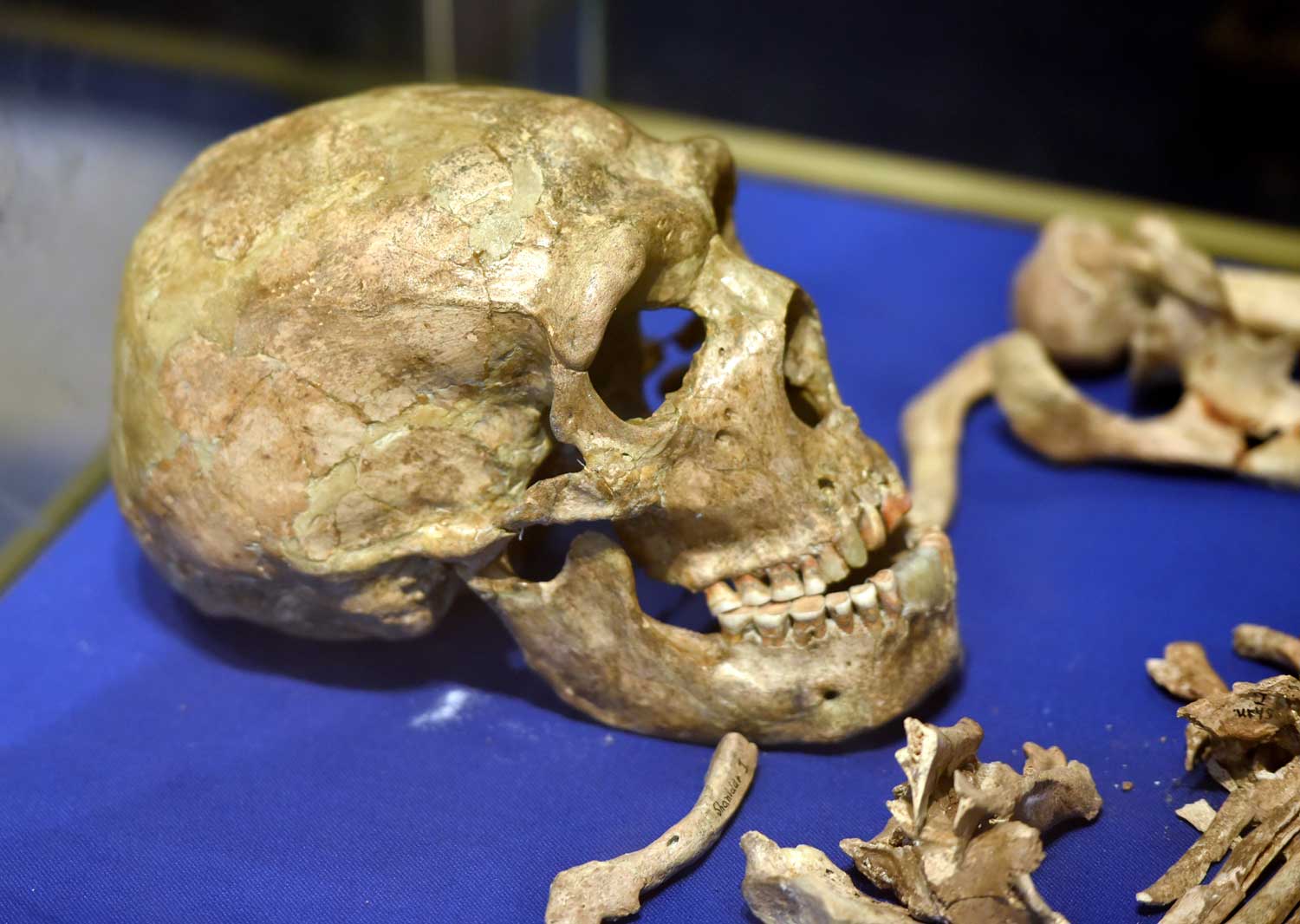
An estimated 58 million people worldwide in 2017 were living after traumatic amputation of one or more of their limbs. Adding to this total are a growing number who have had amputations due to the complications of diabetes, cancer, or peripheral artery disease. These numbers approach one percent of all people on Earth.
Archaeologists have found many skeletons of ancient people who lived after amputation of one or more limbs. Most of these date to the last few thousand years and only a tiny number are from times before 20,000 years ago. This year, a very early case of amputation was in the news when Tim Ryan Maloney and coworkers, of Griffith University, reported finding a skeleton of a young person who survived for years following a leg amputation more than 31,000 years ago, from Liang Tebo, Indonesia.
Few observations from the skeleton give such a vivid picture of the resilience of ancient people in the face of physical challenges. Some researchers have emphasized survival after amputation as evidence of systems of care in ancient human societies. Anthropologists have identified two cases of Neandertals with probable arm amputations, which suggest post-traumatic care in their populations.
But skeletal evidence from the deep past leaves many unknowns. Many nonhuman primates also live with losses of limbs, which they survive without surgical intervention or direct care from other individuals in their groups. As primatologists have learned more about how individuals cope with disabilities, those who study the archaeological record must ask: How real are notions of ancient care, and how much is wishful thinking?
The Liang Tebo case is especially evocative. The cave is one of many caves and rockshelters in the eastern Kalimantan region of Borneo, some with painted walls that date to as early as 40,000 years ago. Maloney and the team excavated a test trench in 2020 and uncovered a human skeleton buried just less than a meter below the cave floor. The skeleton was nearly complete, with third molars in position and estimated to be around 20 years of age. The evidence does not clearly show whether the skeleton belonged to a female or male individual.
A cluster of limestone rocks were above the head and arms. In cross-section the team could see a the line between grave fill and underlying sediment, suggesting that the ancient people had dug this grave.
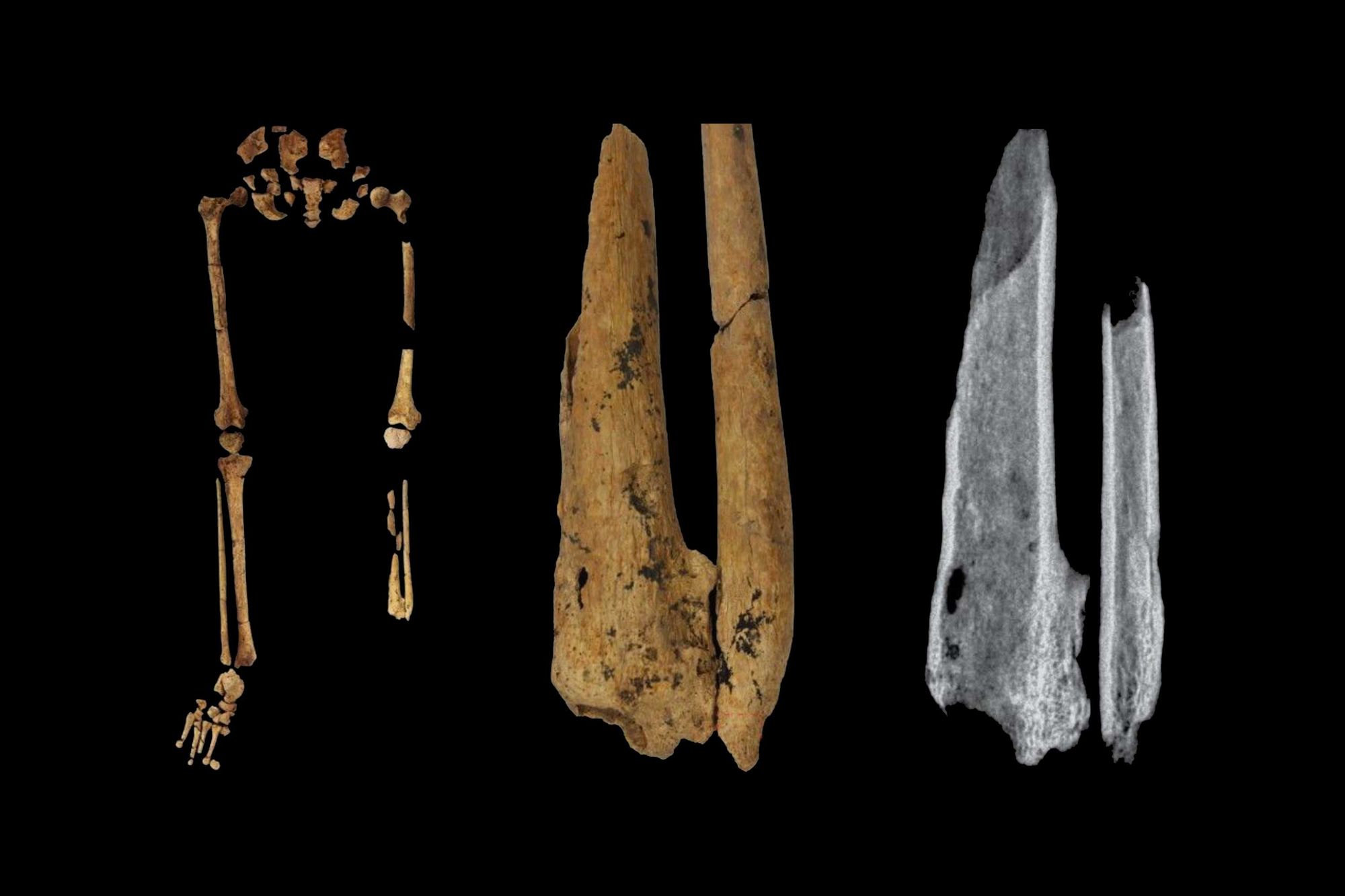
The skeleton's left tibia and fibula were severed at the same place, and the lower parts of these bones and the foot were absent from the grave. On both the tibia and fibula, disordered bone tissue grew after the cut, forming a thickened structure that osteologists call a callus. The callus on the left tibia grew toward the fibula, conforming their stump ends. The intact right tibia and fibula are larger and thicker than the remaining portions of the left side.
Maloney and coworkers suggested that the leg may have been amputated while this individual was still a child, so that the severed bones had not attained the adult size seen in the right leg. The challenging life of this individual is further revealed by other aspects of the skeleton. The axis vertebra broke at some time during the individual's life, which disrupted its alignment with the third cervical vertebrae just below it. In addition to the broken neck, the individual's right knee joint had begun to degenerate, possibly a result of the different pattern of walking the individual must have adopted after losing the left foot.
Archaeologists have found two Neandertals that survived after amputation of limbs. The more famous is the Shanidar 1 skeleton from present-day Iraq. This individual was first unearthed by a team of archaeologists led by Ralph Solecki of the National Museum of Natural History in 1956. Today, archaeologists think that the Shanidar 1 individual lived sometime between 70,000 and 50,000 years ago.
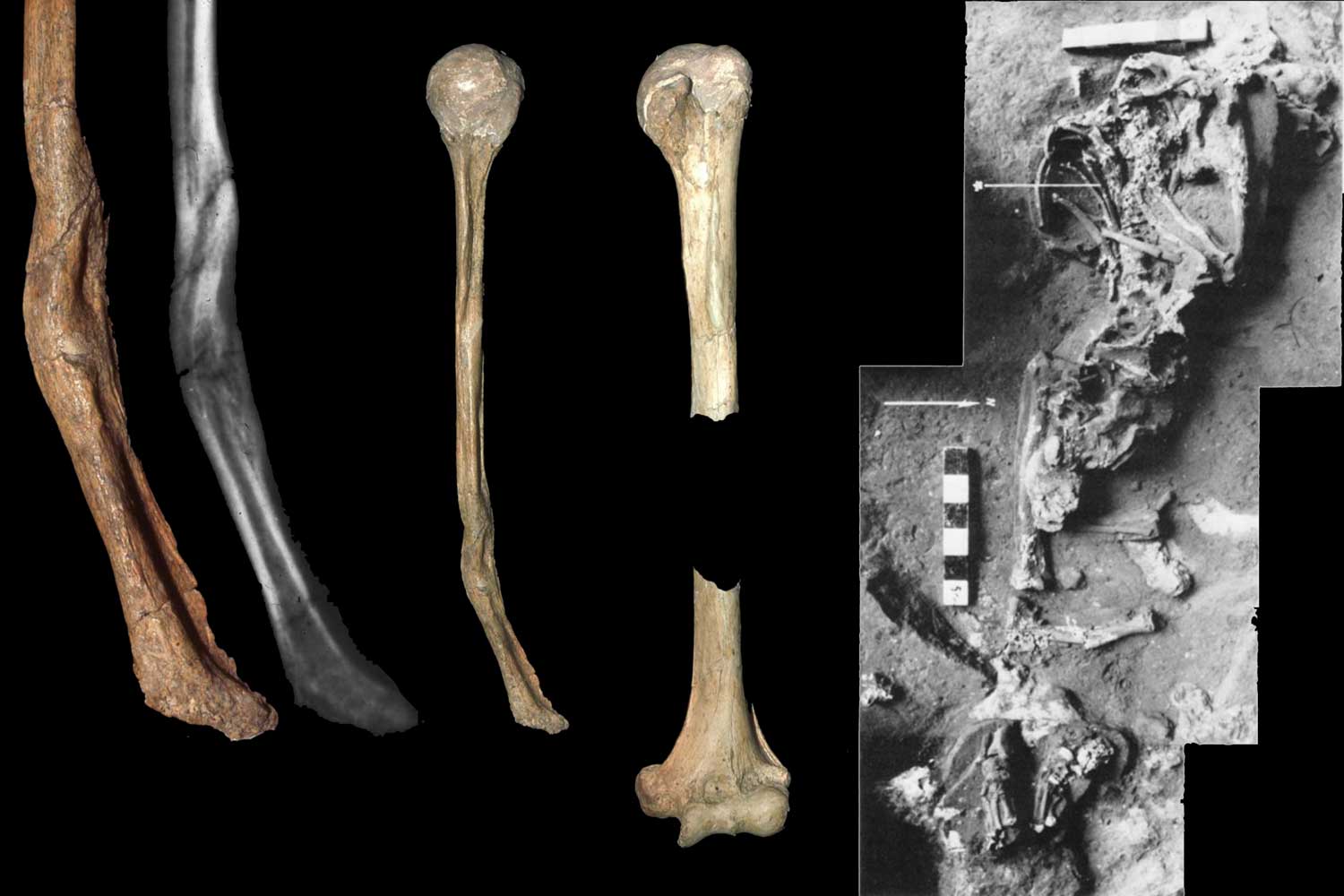
The right humerus of Shanidar 1 is truncated, with a callus of bone at the remaining stump. The anthropologist Erik Trinkaus has noted the angulation that the humerus makes, which may have resulted from several healed fractures or crushing in addition to the one that removed the distal end. It is not evident whether the arm was severed all at once, or whether it may have remained for some time after the initial fracture, only to be amputated later.
An earlier possible case of Neandertal amputation is from the rockshelter of Krapina, Croatia. Dragutin Gorjanović-Kramberger excavated skeletal remains representing as many as 80 individuals from the site between 1899 and 1905. Today our understanding of the site places the time of these Neandertals around 120,000 years ago, roughly the time of the last interglacial period.
Krapina 180 is a right ulna that was truncated during life. It has a rounded distal end with bone growth forming a callus. Gorjanović-Kramberger noticed the ulna and suggested that the individual may have had a nonunion fracture—that is, a fracture that was not set properly, so that the proximal end of the ulna would have healed separately from the distal end. In such cases the broken ends can heal in a way that resembles a “false joint”, or pseudoarthrosis.
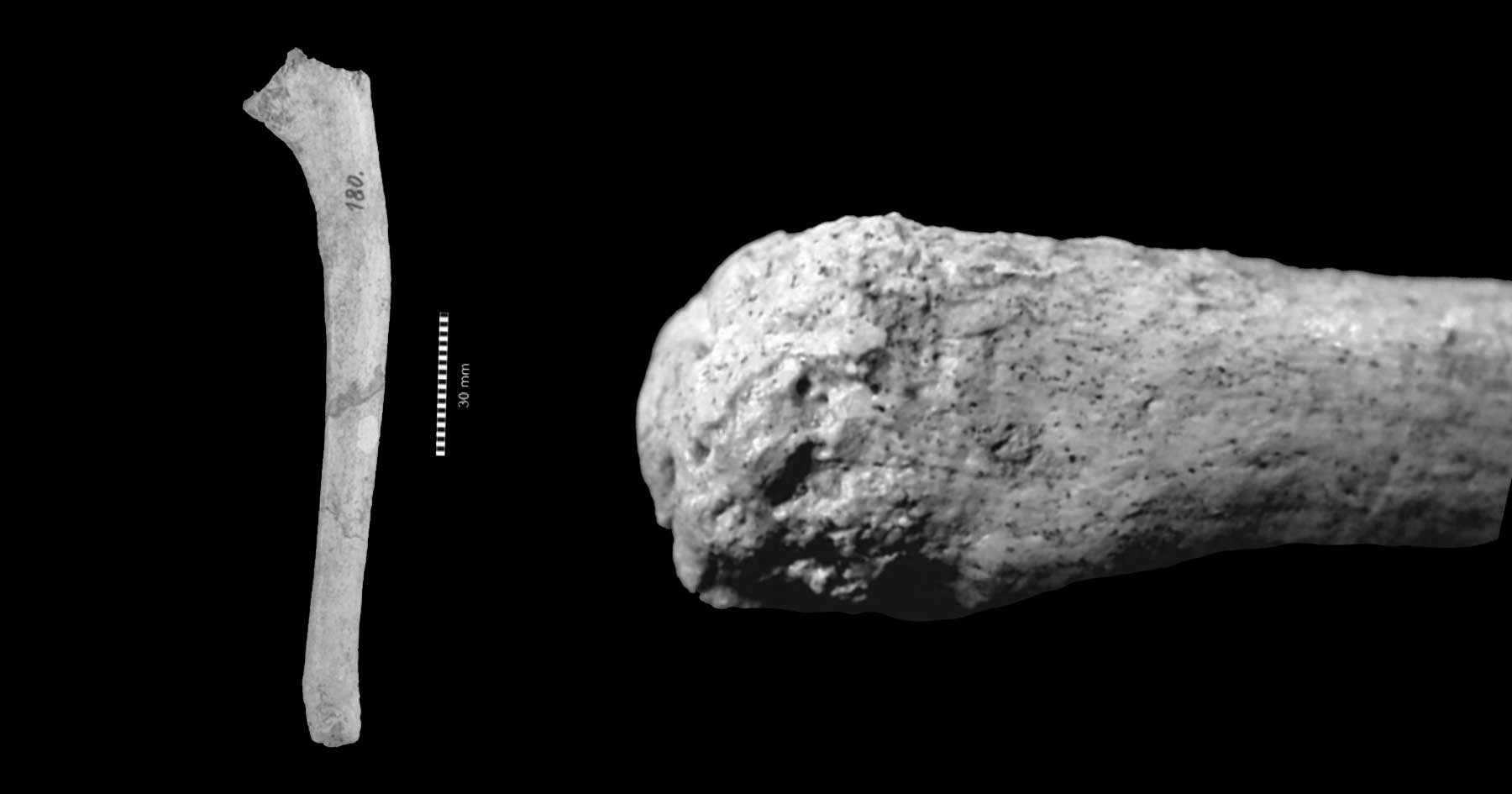
Later authors suggested that amputation might be a more likely explanation. Diane Eddie examined the evidence for Krapina 180 in comparison with a series of documented cases of amputation and nonunion fractures. She found that most of the bones with nonunion fractures had several aspects that were lacking in the Krapina ulna, such as a polishing of the bone surface, called eburnation. Her conclusion was that the bone likely does represent a case of amputation.
What injuries were suffered by these ancient people that led to the amputation of a limb? Many amputees from the last few centuries have left their stories and experiences for historians. Both the surgery itself and the experiences of amputees were remarkably varied. In prehistoric times, without direct evidence, anthropologists have to work from analogy with these known histories.
The earliest written reference to amputation is in the Rig Veda, which describes the battlefield leg amputation of Queen Vispala. The story is at least partly mythical and light on detail: The queen rides back into the battle after donning a prosthetic. But the myth does point to a reality that war injuries caused amputations from at least Bronze Age times. An early historic case was described by Herodotus in a story related by John Kirkup:
“The prisoner, Hegesistratus, chained by his lower leg, was able to free himself by amputating his foot, most probably assisted by gangrenous changes due to the chain; subsequently he had a wooden leg made, an early reference to an artificial limb.”
Trauma remains the top cause of amputations today, accounting for more than 60% of cases. War and its lingering effects such as uncleared minefields are important sources of injuries, but even more common are falls, transport accidents, and incidents with mechanical equipment. Among non-traumatic causes of amputation are cancer and vascular disease resulting from conditions like peripheral artery disease or diabetes. Many people lose fingers, toes, or limbs after frostbite or severe burns. Prior to the twentieth-century discovery of antibiotics, cuts, burns, or abrasions occasionally led to dangerous infections that might progress to tissue necrosis or gangrene.
A few of the earliest medical texts describe surgical amputation, showing several commonalities of practice across Greece, Rome, and China. They share an emphasis on separating healthy from necrotic flesh and appropriately covering the wound. Even in Classical times physicians had metal scalpels, saws, and other specialized surgical instruments. Earlier surgeries were carried out with stone blades. Ján Lietava in 1988 published the results of a series of experiments in which he used stone tools to amputate cadaver limbs and pig thighs. Severing the bones took him between 17 and 27 minutes, and he had to switch to new tools at least twice or three times during the procedure.
It is not clear whether some of the earliest amputations, such as the Liang Tebo case, were surgical. They may have started as compound fractures followed by auto-amputation, when injury to the limb leads to tissue death and ultimately limb loss. Compound fractions, and some noncomminuted fractures, can lead to loss of circulation to the soft tissue even with skilled treatment. Such cases are well described in eighteenth-century medical texts. The tales of people who survived limb loss after gangrene are truly exceptional cases of survival.
Individuals like those from Liang Tebo, Shanidar, and Krapina found a path to survival after their injuries. But how many people with similar injuries had similar stories of survival, and how many perished? What many scientists want to understand is whether survival came down to luck and individual resilience, or whether support and intervention from other people in their groups played an essential role.
Our closest living relatives are chimpanzees and bonobos, and they also have high rates of limb loss and hand and foot disabilities. In 2001, John Waller and Vernon Reynolds recorded observations of a group of chimpanzees in the Budongo Forest, finding that eleven out of fifty-two community members had limb disabilities. Amputated fingers and toes were very common, including several individuals who had lost most of the digits on one hand. A study by Takayoshi Kano from the early bonobo field study in Wamba, Democratic Republic of Congo (then known as Zaïre) found that 46 out of 96 individuals suffered from some limb defect.
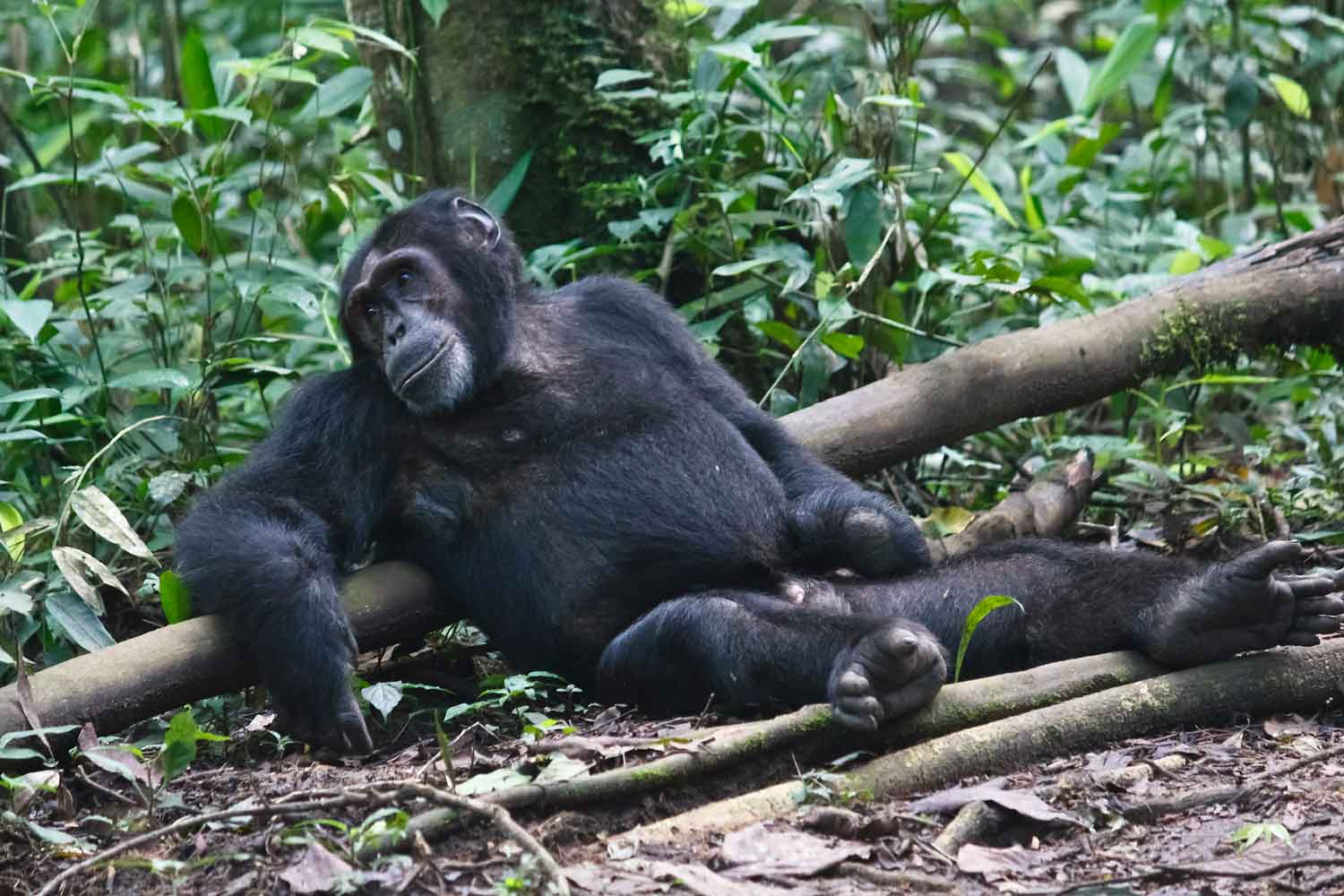
Some of these injuries come from encounters with humans. People have set tens of thousands of wire snares in national parks across Africa and great apes sometimes are caught in them. An ape caught in a snare is likely to pull it tighter and tighter in an attempt to escape. If they succeed in freeing themselves, they often have grievous injuries leading to loss of part or all of a hand or foot. For chimpanzees, even more frequent causes of injuries are falls and attacks by other chimps. Skeletal collections of African apes from the early twentieth century show a pattern of cranial injuries left by bites, long bone fractures from falls, and some healed gunshot wounds from human hunting.
Many primates cope surprisingly well with loss of function of a hand or foot. The chimpanzees of Kibale National Park, Uganda, have been subject to long-term research following the effects of injuries. Marie Cibot and coworkers studied the way that disabled chimpanzees forage for food. They found that chimpanzees with hand and foot disabilities spent as much time in trees and climbed just as high into the canopy as other members of their group. But they did adjust their feeding behavior to their disability, spending less time suspending beneath branches and taking somewhat longer to feed. Researchers have also examined the effects of limb disabilities in free-ranging Japanese macaques. Limb disabilities in this primate do not negatively impact social status, but they do change individuals' activities. Disabled individuals rest more, are chased and bitten by other individuals less often, and spend less time in social interactions.
The Danish journalist Lise Brix wrote about this research in 2015, talking with primatologists like Jessica Hartel and Martin Reinhardt Nielsen who were studying how injured individuals fared in their social relationships. There have been striking stories of survival and adaptation, but other cases of social rejection.
“I've seen chimps in Uganda sitting there without hands leading miserable lives. When a chimp is injured, the others exploit the opportunity to push them down the hierarchy. I remember one chimp in particular, who had lost a hand in a snare. Because it had become weak, other apes then tore its eye out.”—Martin Reinhardt Nielsen
During the early years of Jane Goodall's research on the chimpanzees at Gombe, Tanzania, a high-ranking adult male chimpanzee named Hugo returned to the group one day with a limp, which Goodall suspected was the result of a fall. She observed that it took months for Hugo to walk normally, but he did ultimately recover and died many years later of old age. After Hugo died, the anthropologist Robert Jurmain studied his skeletal remains. Jurmain found eight healed fractures: to the right cheekbone, two ribs, a vertebra, and major healed injuries to the right foot, with a crushing fracture of the right heel, a broken metatarsal, and broken toes. From the bones alone, this would appear to have been a severe trauma with lifelong impacts. Hugo accommodated and healed.
In another memorable episode, the Gombe chimpanzees suffered an epidemic of poliomyelitis in 1966. Two adult male chimpanzees were afflicted by paralysis and loss of function of limbs. In each case, other members of the group reacted with fear and stress to the change in individuals they had previously known. Goodall related in clinical detail the sad end of the individual she had named Gregor. After losing the use of both legs, he could move only with great difficulty. Other members of the group avoided approaching him.
Three of the adult males were initially aggressive when they approached Gregor. They displayed towards and around him as he cowered on the ground, his face split by a huge grin of fear. One of them actually stamped on him, seized his shoulder and tried to roll him over.
For six days most of the group continued avoiding Gregor. He was not involved in social grooming, and others shunned him. Goodall related that he ultimately dislocated one of his arms while trying to climb a tree, and the researchers shot him “for humane reasons.”
Every so often, a meme goes around social media that attributes a profound idea to the twentieth-century anthropologist Margaret Mead. This year Gideon Vasco dug into this meme in an article for SAPIENS:
Margaret Mead was supposedly asked by a student what she thought was the earliest sign of a civilized society. There are many variations of the anecdote, but the general details are similar: To the student’s surprise, Mead replied that the first sign of civilization is a healed human femur—the long bone that connects the hip to the knee.
Mead proceeded to explain, as the story goes, that wounded animals in the wild would be hunted and eaten before their broken bones could heal. Thus, a healed femur is a sign that a wounded person must have received help from others. Mead is said to have concluded, “Helping someone else through difficulty is where civilization starts.”
As he investigated the story, Vasco found that the whole thing is an urban myth. There is no evidence Mead ever said anything of the kind. Still, the wide transmission of this myth reveals something about people's conception of humanity and inhumanity. People see themselves as compassionate helpers. Many consider a civilized society to be one where people protect the injured and give them time and support to heal.
People do help each other. Yet they also hurt each other. Many civilized societies through history have imposed dismemberment as punishment for crimes. Hegesistratus, whom Herodotus described as having amputated his own foot to escape chains, lived in a civilized society. Some of the worst injuries evidenced in human skeletal remains came at the hands of other people.
As I read descriptions of chimpanzee life after injuries and dismemberment, I think of the Shanidar 1 individual. His amputated arm was coupled with injuries across his entire skeleton: healed fractures to the left orbit, injuries to the cranial vault, exostoses of the right lateral femur condyle and abnormal form of the right distal tibia and talus. Were these injuries sustained in a series of unfortunate accidents? Or was he set upon by other people, out of fear or hatred?
Both humans and nonhuman primates show us that survival and life after extreme injuries happen under varied circumstances. Bioarchaeologists tend to highlight severe injuries, which stand out from the more subtle patterns of osteological signs of disease that can be understood only across large samples of skeletons. But such individual stories rarely yield unambiguous interpretations.
To make progress in understanding ancient social systems and healing, anthropologists are looking at the broader picture. A notable recent contribution is the work of Penny Spikins and collaborators, who surveyed cases of healed injuries and developmental disorders across known Neandertal skeletal remains. These researchers note that the most archaeologically visible evidence of assistance to other individuals is likely to appear very costly, and such cases are a poor representation of the more routine practices in ancient societies. They point out that the healthcare practices of recent small-scale foraging societies include the competent treatment of injuries, fevers, and illnesses with provisioning, social support, and medicinal interventions. These researchers accept that such human practices are part of a broader shared pattern of collaborative care among social mammals, including nonhuman primates. There is much more continuity than discontinuity among our ancestors and our more distant primate relatives in sociality and care.
Personally, I see every story of survival against the odds as an achievement. Extreme cases may be poor examples for testing hypotheses about ancient social systems, but they reveal much about what humans share with each other and with our distant ancestors.
Notes: The Liang Tebo case is described in a research paper by Maloney and coworkers (2022). An accompanying Nature News piece by McKenzie Prillaman (2022) provides some context for the discovery.
Many authors have looked at injuries in Neandertals and what they mean for understanding social relationships and care. Virginia Estabrook and David Frayer (2013) provide a clear discussion of the Krapina skeletal evidence, including Krapina 180, and Eddie (2013) examined that particular case in a comparative framework. The open access paper by Trinkaus and Villotte (2017) has a detailed supplement with an up-to-date discussion of the Shanidar 1 individual.
The historical evidence of amputation is well discussed in a 1944 article by Kirk, and today's readers will appreciate the book by Kirkup, which is somewhat less clinical in focus. The historical cases I discuss come from these sources. I also consulted a number of articles about U.S. Civil War medical practices, but these ended up cut from the final post. I've left these in the reference list because they provide very interesting perspectives.
There is a growing literature on disability in wild primates. The work on free-ranging Japanese macaques and disability comes from a 2014 study by Sarah Turner and coworkers. The studies cited here focusing mostly on chimpanzees and bonobos are some of the most profound in terms of their observations of groups in which many individuals live with lost function in hands or feet. The Kibale Chimpanzee Project has a website describing its Snare Removal Program. Goodall's 1986 work describing the social rejection of individuals suffering from polio is especially striking. Goodall collaborated with Robert Jurmain and Adrienne Zihlman on research comparing field observations to the skeletal remains of individual chimpanzees.
References
Anderson, J. R. (2018). Chimpanzees and death. Philosophical Transactions of the Royal Society B: Biological Sciences, 373(1754), 20170257. https://doi.org/10.1098/rstb.2017.0257
Aubert, M., Brumm, A., Ramli, M., Sutikna, T., Saptomo, E. W., Hakim, B., ... & Dosseto, A. (2014). Pleistocene cave art from Sulawesi, Indonesia. Nature, 514(7521), 223-227. https://doi.org/10.1038/nature13422
Brix, L. (2015) Snarer skærer hænder og fødder af chimpanser. Videnskab.dk https://videnskab.dk/miljo-naturvidenskab/snarer-skaerer-haender-og-fodder-af-chimpanser
Cibot, M., Krief, S., Philippon, J., Couchoud, P., Seguya, A., & Pouydebat, E. (2016). Feeding Consequences of Hand and Foot Disability in Wild Adult Chimpanzees (Pan troglodytes schweinfurthii). International Journal of Primatology, 37(4), 479–494. https://doi.org/10.1007/s10764-016-9914-0
Detwiler, K. M., Nkoranigwa, M., Detwiler, C. K., & Whittier, C. A. (2019). Auto-amputation Following Acute Traumatic Forelimb Injury in a Wild Cercopithecus Monkey. African Primates, 13, 39–46.
Eddie, D. M. (2013). Examination of Trauma in a Neandertal Ulna. M.A. thesis dissertation, University of Kansas.
Estabrook, V. H., & Frayer, D. W. (2013). Trauma in the Krapina Neandertals: violence in the Middle Palaeolithic? In The Routledge Handbook of the Bioarchaeology of Human Conflict (pp. 67-89). Routledge.
Goodall, J. (1986). Social rejection, exclusion, and shunning among the Gombe chimpanzees. Ethology and Sociobiology, 7(3), 227–236. https://doi.org/10.1016/0162-3095(86)90050-6
Jurmain, R. (1997). Skeletal evidence of trauma in African apes, with special reference to the Gombe chimpanzees. Primates, 38(1), 1–14. https://doi.org/10.1007/BF02385918
Jurmain, R. (1989). Trauma, degenerative disease, and other pathologies among the Gombe chimpanzees. American Journal of Physical Anthropology, 80(2), 229–237. https://doi.org/10.1002/ajpa.1330800211
Kano, T. (1984). Observations of physical abnormalities among the wild bonobos (Pan paniscus) of Wamba, Zaire. American Journal of Physical Anthropology, 63(1), 1–11. https://doi.org/10.1002/ajpa.1330630102
Kirk, N. T. (1944). The development of amputation. Bulletin of the Medical Library Association, 32(2), 132–163.
Kirkup, J. (2007). A History of Limb Amputation. Springer. https://doi.org/10.1007/978-1-84628-509-7
Lasco, G. (2022). Did Margaret Mead Think a Healed Femur Was the Earliest Sign of Civilization? SAPIENS. (June 16, 2022) https://www.sapiens.org/culture/margaret-mead-femur/
Lietava, J. (1988). A differential diagnostics of the right shoulder girdle deformity in the Shanidar I neanderthal. Anthropologie, 183-196.
McDonald, C. L., Westcott-McCoy, S., Weaver, M. R., Haagsma, J., & Kartin, D. (2020). Global prevalence of traumatic non-fatal limb amputation. Prosthetics and Orthotics International, 0309364620972258. https://doi.org/10.1177/0309364620972258
Maloney, T. R., Dilkes-Hall, I. E., Vlok, M., Oktaviana, A. A., Setiawan, P., Priyatno, A. A. D., ... & Aubert, M. (2022). Surgical amputation of a limb 31,000 years ago in Borneo. Nature, 609, 547–551. https://doi.org/10.1038/s41586-022-05160-8
Prillaman, M. (2022) Prehistoric child’s amputation is oldest surgery of its kind. Nature https://doi.org/10.1038/d41586-022-02849-8
Reilly, R. F. (2016). Medical and surgical care during the American Civil War, 1861–1865. Proceedings (Baylor University. Medical Center), 29(2), 138–142.
Spikins, P., Needham, A., Wright, B., Dytham, C., Gatta, M., & Hitchens, G. (2019). Living to fight another day: the ecological and evolutionary significance of Neanderthal healthcare. Quaternary Science Reviews, 217, 98-118. https://doi.org/10.1016/j.quascirev.2018.08.011
Tokoyama, N. (2019). Snare-related disability led to the near-fatal accident of a bonobo at Wamba, Democratic Republic of the Congo. Pan Africa News, 26(1), 7–9.
Trinkaus, E. (1983). The Shanidar Neandertals. Academic Press.
Trinkaus, E., & Villotte, S. (2017). External auditory exostoses and hearing loss in the Shanidar 1 Neandertal. PLoS One, 12(10), e0186684. https://doi.org/10.1371/journal.pone.0186684
Turner, S. E., Fedigan, L. M., Matthews, H. D., & Nakamichi, M. (2014). Social consequences of disability in a nonhuman primate. Journal of Human Evolution, 68, 47–57. https://doi.org/10.1016/j.jhevol.2014.01.002
Waller, J. C., & Reynolds, V. (2001). Limb injuries resulting from snares and traps in chimpanzees (Pan troglodytes schweinfurthii) of the Budongo Forest, Uganda. Primates, 42(2), 135-139. https://doi.org/10.1007/BF02558140
Zäuner, S. P., Wahl, J., Boyadziev, Y., & Aslanis, I. (2013). A 6000‐Year‐Old Hand Amputation from Bulgaria—The Oldest Case from South‐East Europe?. International Journal of Osteoarchaeology, 23(5), 618-625. https://doi.org/10.1002/oa.1277
John Hawks Newsletter
Join the newsletter to receive the latest updates in your inbox.



